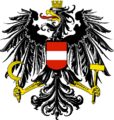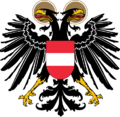Coat of arms of Austria facts for kids
Quick facts for kids Coat of arms of Austria |
|
|---|---|
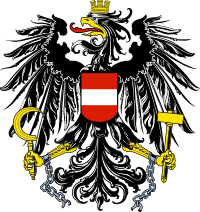 |
|
| Versions | |
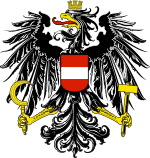
First Republic, 1919–1934
|
|
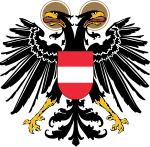
Federal State ("Corporate" State) 1934–1938
|
|
| Armiger | Republic of Austria |
| Adopted | 1945 |
| Crest | A mural crown Or |
| Blazon | Gules, a fess argent (arms of the Duchy of Austria, flag of Austria) |
| Supporters | An eagle sable gambed Or displayed |
| Other elements | The eagle bears a sickle Or in dexter talon and a hammer Or in sinister talon. The gambs also bear broken iron chains. |
| Earlier version(s) | As current version but without broken chains (1919–1934), Imperial-style double headed eagle (1934–1938) |
The coat of arms of Austria is an important national symbol. It has been used by the country since 1919. For a short time between 1934 and 1938, Austria used a different design. This older design featured a two-headed eagle. In 1945, the original coat of arms was brought back. Some broken chains were added to it then. These chains represent Austria's freedom.
Contents
What the Austrian Coat of Arms Means
The Austrian coat of arms is full of special symbols. Each part tells a story about the country's history and values. Here's what each symbol means:
The Eagle: A Symbol of Freedom
The eagle on the coat of arms stands for Austria's freedom. It was first introduced in 1919. This powerful bird shows strength and independence.
The Shield: Austria's Colors
The shield in the middle of the eagle is called an escutcheon. It shows the colors red, white, and red. These are the colors of the flag of Austria. This design has been an emblem of Austria since the Middle Ages. It was brought back in 1915.
The Crown: For the People
The crown on the eagle's head is a mural crown. It looks like a city wall. This crown represents the middle class citizens of Austria. It was added to the coat of arms in 1919.
The Sickle and Hammer: Working Together
The eagle holds a sickle in one claw and a hammer in the other.
- The sickle represents agriculture, which is farming.
- The hammer stands for industry, which means factories and manufacturing.
Both were added in 1919. They show the importance of both farmers and workers in Austria.
The Broken Chains: Freedom from Oppression
Perhaps the most powerful symbol is the broken chains. These chains are wrapped around the eagle's feet. They were added in 1945. The broken chains show that Austria broke free from a very strict and oppressive government. They represent the country's freedom from a difficult time in its history.
Images for kids
See also
 In Spanish: Escudo de Austria para niños
In Spanish: Escudo de Austria para niños


